The Lazi Church, or San Isidro Labrador Parish Church, is a Roman Catholic church in the municipality1 of Lazi2 (formerly Tigbawan), in the province3 of Siquijor4, Philippines.
 Greg – originally posted to Flickr https://en.wikipedia.org/wiki/Lazi_Church#/media/File:St._Isidore_the_Laborer_Church_in_Lazi,_Siquijor.jpg
Greg – originally posted to Flickr https://en.wikipedia.org/wiki/Lazi_Church#/media/File:St._Isidore_the_Laborer_Church_in_Lazi,_Siquijor.jpg
It is under the jurisdiction of the Diocese of Dumaguete5. It became an independent parish on August 8, 1857. The sea stone-wood, neoclassical-style6 church was built in 1884 by Filipino artisans, followed by the bell tower the following year, under the direction of Recollect7 priest Father Toribio Sanchez. The church has two pulpits, and has retained its original retablo8 and wood floorings.
This church was my group’s fourth stop (out of six) during our one-day Siquijor Coastal Tour. We rented an air-conditioned van owned by Yane’s Adventures Van Services6 after we arrived at the port of Siquijor. We were lucky to have a very cheerful and accommodating driver, Jimmy Bueno.
I wanted to enter this 135-year old church, see the belfry, light a candle, and take pictures, including the grotto, but when we visited it on March 25, 2019, it was closed for renovation. Perhaps, this is one reason why I should return to this island province3. Great news, target date of completion is May 21, 2019! Please give me feedback if this target was met.
Great news, target date of completion is May 21, 2019! Please give me feedback if this target was met.
Anyway, at the opposite side of the street is the church’s big convent. The construction of this U-shaped, bahay na bato10 convent was made with coral stones and hardwood, commenced in 1887, and completed in 1891, also under Fr. Toribio.
 The Lazi Convent in 2012 (Carmelo Bayarcal, own work created June 10, 2012, https://en.wikipedia.org/wiki/Lazi_Church#/media/File:Lazi_Convent_Color.JPG)
The Lazi Convent in 2012 (Carmelo Bayarcal, own work created June 10, 2012, https://en.wikipedia.org/wiki/Lazi_Church#/media/File:Lazi_Convent_Color.JPG)

It is one of the largest convents built during the Spanish colonial era11, at 42 meters by 38 meters (138 ft. by 125 ft.). The ground floor has stonewalls and the second floor has wooden panels. A street sweeper I talked with said that this convent is the largest and oldest in Asia. I need to research to verify that claim.
The convent is funded by donations from parishes and missions of the Recollects7. Partitions of the convent were removed, but the original structure was maintained. It now houses the Siquijor Heritage Museum which has collections of important church relics and paraphernalia.
Unfortunately, I did not have the chance to enter this convent. I merely took pictures of it from the road. I also admired, took pictures, and touched the three trees along the street which look like at least a hundred years old. 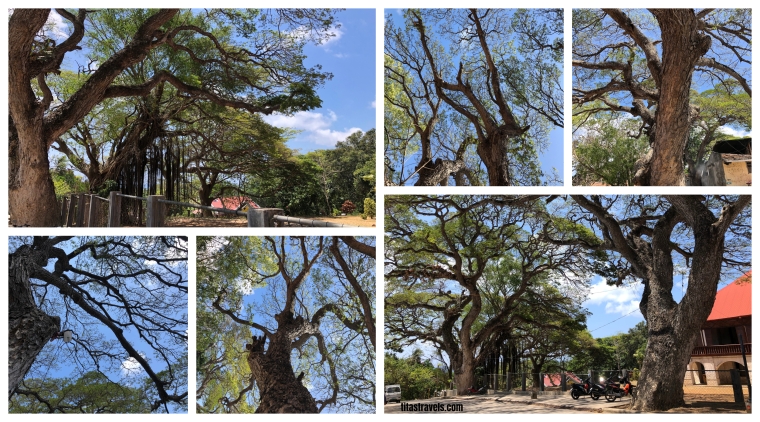
Lazi Church was declared a National Historical Landmark12 by the National Historical Commission of the Philippines13 in 1984, and a National Cultural Treasure14 by the National Museum of the Philippines15 in 2001. It was also nominated to be part of the UNESCO World Heritage Sites16 Tentative List since 2006, under the collective group of Baroque17 Churches of the Philippines (Extension), together with the churches of Patrocinio de Maria in Boljoon, Cebu; La Immaculada Concepcion in Guiuan, Eastern Samar; San Pedro Apostol in Loboc, Bohol; and San Mattias in Tumauini, Isabela. In 2014, the government announced its plan to nominate this church in the World Heritage List.
 Lazi Church in 2016 (Allan Jay Quesada, own work, 20 April 2016, https://commons.wikimedia.org/wiki/File:Allan_Jay_Quesada_-_Lazi_Church_DSC_2365.jpg)
Lazi Church in 2016 (Allan Jay Quesada, own work, 20 April 2016, https://commons.wikimedia.org/wiki/File:Allan_Jay_Quesada_-_Lazi_Church_DSC_2365.jpg)
The information was obtained from the Wikipedia pages “Lazi, Siquijor”18 and “Siquijor”19.
We paid for our Siquijor Coastal Tour and all comments are based on my personal experience in this province3.
You can read related posts about my Siquijor tour: TAKE A TARZAN-LIKE DIVE AT CAMBUGAHAY FALLS, SIQUIJOR!, ENCHANTING 400-YEAR-OLD BALETE TREE AND FISH SPA, SIQUIJOR, SERENE AND SPONTANEOUS SALAGDOONG BEACH, SIQUIJOR, GET BEWITCHED AT HAPITANAN, SIQUIJOR, PALITON BEACH: THE LITTLE BORACAY OF SIQUIJOR, and Now You Know – SIQUIJOR: ITS LEGEND, HISTORY, TRADITIONS, AND BELIEFS.
Did you find this post informative? I would like to hear from you re your visit to this historical church and convent. Simply scroll and click “Leave a comment”.
See other interesting places through other posts in this category and other categories of SCapades, Pinoy Delights, and Smart Travelers – Foreign Travelers Ask, Now You Know, and Say, Say, Say. Happy reading, and I hope that you will appreciate what I shared and some of the featured destinations will be part of your future travel plans!
Remember to share this post with your friends, follow me by clicking on the bottom right corner of your device, and do not forget to like this post. Thank you.
– – – – – – – – – – – – – – – – – – – – – – – – – –
The following terms are defined for interested readers, especially non-Filipinos, those with “Senior-Moments”, and those too busy or lazy to Google such terms:
1A municipality is a small, single urban administrative division, or local government unit (LGU)20, in the Philippines which has corporate status and powers of self-government or jurisdiction as granted by law. It is a unit under a province3, subdivided into barangays21, and is called town, or “bayan”. In the Philippines, a municipality is headed by a mayor, a vice mayor and members of the Sangguniang Bayan (legislative branch). It can enact local policies and laws, enforce them, and govern its jurisdictions. It can enter into contracts and other transactions through its elected and appointed officials, and can tax as well. It enforces all local and national laws. The information was obtained from Wikipedia page “Municipalities of the Philippines.”22
2Lazi, formerly called Tigbawan, is a coastal municipality1 in the island province3 of Siquijor4, with 18 barangays21. It is located in the southeastern side of the island, between the towns of San Juan in the west and Maria from the east. It is known for its Roman Catholic church called San Isidro Labrador Parish Church (see above), the Convent in front of it (see above), the 400-yo enchanting balete tree with fish spa (see my post: ENCHANTING 400-YEAR-OLD BALETE TREE AND FISH SPA, SIQUIJOR), and Cambugahay Falls (where you can accept the Tarzan Swing-Dive Challenge; see my post: TAKE A TARZAN-LIKE DIVE AT CAMBUGAHAY FALLS, SIQUIJOR!). The information was obtained from the Wikipedia page “Lazi, Siquijor”18 and “Siquijor”19. Visit this site for more information: http://www.phtourguide.com/municipality-of-lazi-in-siquijor/
3A province is the primary administrative and political division in the Philippines. It is the second-level administrative sub-division of a region23. There are 81 provinces (called “lalawigan”) in the Philippines. Each province is governed by an elected legislature called the Sangguniang Panlalawigan and by an elected governor. In the Philippines, a province is divided into cities24 and municipalities1 (or towns), which in turn, are divided into barangays21, formerly called barrios. The information was obtained from Wikipedia page “Provinces of the Philippines.”25 See a related post: Foreign Seniors Ask: WHAT ARE PROVINCES IN THE PHILIPPINES?
4Siquijor is an island province3 of the Philippines located in the Central Visayas Region (Region VII)26. Its capital is the municipality1 which is also called Siquijor. This coralline island is predominantly hilly, and in many places the hills reach the sea, producing steep cliffs. Geographically, Cebu is to the north, Negros to the west, Bohol to the northeast, and to the south, across the Bohol Sea, is Mindanao. It has a long-time reputation as a place of magic, sorcery, and mystical traditions. It is also well known for its festivals that focus on healing rituals where incantations are sung, while the old folks make potions out of herbs, roots, insects, and tree barks. The information was obtained from the Wikipedia page “Siquijor”.19
5Dumaguete is the capital city24 and main port of Negros Oriental, a province3 in Central Visayas (Region VII)26, of the Philippines. This laid-back university town is called the “City of Gentle People”. It has a charming sea-front boulevard, the most popular destination in the Philippines for retiring abroad, and among the top 10 tourist destinations in the country. The information was obtained from the Wikivoyage page “Dumaguete”.27
6Neoclassical architecture is an architectural style that began in the mid-18th century, characterized by grandeur of scale, simplicity of geometric forms, dramatic use of columns, Greek/Roman detail, and a preference for blank walls.28
7The Recollects were a French reform branch of the Order of Friars Minor created at the end of the 15th century, commonly known today as the Franciscans, best known for their presence as missionaries in various parts of the world. They wore gray habits and pointed hoods, took vows of poverty, and devoted their lives to prayer, penance, and spiritual reflection. In 1897, Pope Leo XIII officially dissolved the Recollects order and integrated it as a part of the Franciscan order, officially changing their name to Friars Minor. The information was obtained from the Wikipedia page “Recollects”.29
8A retablo is the altarpiece, the main feature of old Roman Catholic churches. This upright panel, intricately carved, gilded, polychromed, and highly decorated, has a wooden frame and contains ledges and panels behind and above the altar. It is embellished with decorative features like rosettes, grapevines, scrolls, and cherubs, crafted by native artisans. It has several niches for the patron saint, usually located in the topmost portion, while other saints, affiliated to the religious order which takes care of the church, occupy both sides of the second and third levels.30
9Yane’s Adventures Van Services information – Address: Pangi, Siquijor, Siquijor; Contact numbers: 09052133123, 09069732330 and 09183124461, look for Jade JumawanPestillos, and request for our very accommodating and cheerful driver, Jimmy Bueno.
10Bahay na bato, literally “house of stone”, is the Filipino term for a type of building originating during the Philippines’ Spanish Colonial period11, with a rectangular plan, popular among the elite and middle-class. It is an elevated, overhanging wooden upper-story nipa hut31 with balustrades, ventanillas (small windows), and capiz32 shell sliding windows. It stands on Spanish-style solid stone blocks or bricks and posts as foundation, and not wood, bamboo stilts, or timber posts. Roofing is either Chinese tiled roof or thatch (nipa, sago, palm or cogon), many today have been replaced by galvanized, or other modern, roofing. The information was obtained from the Wikipedia page “Bahay na bato”.33
11The Spanish colonial era was the historical part of the Philippines from 1521, when European explorer Ferdinand Magellan arrived in the country, and ended in 1898, with the outbreak of the Philippine Revolution34. The information was obtained from the Wikipedia page “History of the Philippines from 1521 to 1898”.35
12A National Historical Landmark of the Philippines is a place or an object that is associated with an event, achievement, characteristics or modification that presents a turning point or stage in history. The information was obtained from the Wikipedia page “Category: National Historical Landmarks of the Philippines”.36
13The National Historical Commission of the Philippines (NHCP) is a government agency of the Philippines which promotes Philippine history and cultural heritage through research, dissemination, conservation, sites management, and heraldry works, thereby inculcating awareness and appreciation of the noble deeds and ideals of our heroes and other illustrious Filipinos, instilling pride in the Filipino people, and rekindling the Filipino spirit through the lessons of history. The information was obtained from the Wikipedia page “National Historical Commission of the Philippines”.37
14A National Cultural Treasure (NCT) of the Philippines is a tangible (movable and immovable) or intangible heritage property declared by the National Commission for Culture and Arts38 and other cultural agencies such as the National Museum of the Philippines15, National Library of the Philippines39, and National Archives of the Philippines40. Such declarations are authorized under the National Cultural Heritage Act of 200941 and recognized within the Cultural Properties of the Philippines42 by the Philippine government. The title of NCT is the highest designation given to a “unique cultural property found locally, possessing outstanding historical, cultural, artistic and/or scientific value which is highly significant and important to the country and nation”.43 The information was obtained from the Wikipedia page “National Cultural Treasure”.44
15The National Museum of the Philippines is a government institution in the Philippines which serves as the educational, scientific and cultural institution in preserving the various permanent national collections featuring the ethnographic, anthropological, archaeological and visual artistry of the Philippines. It was formed on October 29, 1901, with headquarters in Padre Burgos Avenue, in Rizal Park, Ermita, Manila. Since 1998, it has been the regulatory and enforcement agency of the national government in restoring and safeguarding important cultural properties, sites and reservations throughout the Philippines. It is under the Department of Education and the National Commission for Culture and Arts38. The information was obtained from the Wikipedia page “National Museum of the Philippines”.45 Visit its website: www.nationalmuseum.gov.ph
16A UNESCO World Heritage Site (WHS) is a unique landmark, or geographically and historically identifiable place, which is selected by the United Nations Educational, Scientific and Cultural Organization (UNESCO) as having cultural, historical, scientific, physical or other form of significance, and is legally protected by international treaties. Sites are demarcated by UNESCO as protected zones. The list is maintained by the International World Heritage Program administered by the UNESCO World Heritage Committee, composed of 21 state parties which are elected by the General Assembly. Under certain conditions, listed sites can obtain funds from the World Heritage Fund. The information was obtained from the Wikipedia page “World Heritage Site”.46
17Baroque architecture began in Rome, Italy, in the late 16th century, which conveys grandeur and drama, most often used in palaces and churches. It includes curving forms, oval shapes, and a combination of concave and convex forms that make walls seem to undulate, or appear wavy, with a strong sense of motion. It groups things together like columns and decorative flourishes on building surfaces. Architectural elements are repeated across a surface. It uses distortion to make figures elongated, broken, or manipulated in some manner to make them stand out. Buildings have columns, sometimes topped with capitals and large volutes, scroll, or spiral forms. Sculptural wall elements will often project from the surface which is full of forms to increase the interplay of light and shadow across them. Inside, Baroque structures will often have ceilings painted in bright colors, made to fool one’s eye into believing one is looking at the sky. Buildings also have very rich surface treatments, including interiors with stucco47, various colored marbles, and gold gilt or thin sheets of gold applied to surfaces. Most Baroque churches have vaulted ceilings, supported by a series of interconnected arches.48
18“Lazi, Siquijor,” accessed March 8, 2019,https://en.m.wikipedia.org/wiki/Lazi,_Siquijor
19“Siquijor,” accessed March 8, 2019,https://en.m.wikipedia.org/wiki/Siquijor
20A local government unit (LGU) in the Philippines is divided into 3 levels: provinces3 and independent cities49; component cities50 and municipalities1; and, barangays21, according to Wikipedia page “Local government in the Philippines”.51
21A barangay in the Philippines is the smallest administrative division in the Philippines, headed by a barangay captain, aided by a Sangguniang Barangay (Barangay Council). It is the native Filipino term for a district or village. It was formerly called a barrio. In a metropolitan area, a barangay is an inner city neighborhood, a suburb, or a suburban neighborhood. The word barangay originated from the term “balangay”, a kind of boat used by a group of Austronesian people who migrated to the Philippines. A number of barangays grouped together is called a district. The information was obtained from Wikipedia page “Barangay.”52
22“Municipalities of the Philippines,” accessed January 29, 2019, https://en.wikipedia.org/wiki/Municipalities_of_the_Philippines
23A region is the first-order administrative division in the Philippines. There are 17 regions in the Philippines, based on geographical, cultural and ethnological characteristics. It is further subdivided in provinces3, composed of cities and municipalities1 (or towns), which in turn, are divided into barangays21. The regions were initially identified in 1972, through Presidential Decree No. 1 of President Ferdinand Marcos. Since then, other regions have been created and some provinces have been “transferred” to another region. The information was obtained from Wikipedia page “Regions of the Philippines.”53
24A city is the local government unit20 in the Philippines headed by a mayor elected by popular vote. A vice-mayor serves as the presiding officer of the city’s legislative body – the Sangguniang Panlungsod (city council). The information was obtained from Wikipedia page “Cities of the Philippines.”54
25“Provinces of the Philippines,” accessed July 17, 2018, https://en.wikipedia.org/wiki/Provinces_of_the_Philippines
26Central Visayas (Region VII) of the Philippines is a Philippine region23 located in the island group of Visayas55, with Cebu City as its regional center. It has 7 local government units20 (LGUs): Bohol, Cebu, Cebu City, Lapu-Lapu, Mandaue, Negros Oriental, and Siquijor4. The information was obtained from Wikipedia page “Regions of the Philippines.”53
27“Dumaguete,” accessed March 8, 2019,https://en.wikivoyage.org/wiki/Dumaguete
28https://www.britannica.com/art/Neoclassical-architecture
29“Recollects,” accessed March 8, 2019,https://en.m.wikipedia.org/wiki/Recollects
30http://www.nationalmuseum.gov.ph/nationalmuseumbeta/Collections/Retablo.html
31The nipa hut, bahay kubo, payag or kamalig, is a type of native, stilt house of the indigenous people of the Philippines before the Spaniards arrived in 1521, similar to neighboring countries in Southeast Asia like Indonesia and Malaysia. It often serves as an icon of Philippine culture or, more specifically, rural cultures, designed to endure the climate and environment of the country. It was made from plant materials, like bamboo, which was easily accessible and acquired to rebuild it when damaged by a storm or earthquake. The information was obtained from the Wikipedia page “Nipa hut”.56
32Capiz, or kapis, is the shell of the windowpane oyster (Placuna placenta), an edible, bivalve marine mollusk in the family of Placunidae. It is durable and translucent so it is used as a glass substitute for windows, and even decorative items like chandeliers and lampshades. The information was obtained from the Wikipedia page “Windowpane oyster”.57
33“Bahay na bato,” accessed March 8, 2019,https://en.m.wikipedia.org/wiki/Bahay_na_Bato
34The Philippine Revolution is the revolution that started on August 23, 1896 when the Spaniards discovered the Katipunan58, and ended in August 13, 1898. The Filipinos were victorious, and this resulted in the expulsion of the Spanish colonial government, as well as the: signing of the Pact of Biak-na-Bato59 in 1897; resumption of hostilities during the Spanish-American War60 in 1898; the establishment of the First Philippine Republic61; and, the outbreak of the Philippine-American War62 in 1899. The information was obtained from the Wikipedia page “Philippine Revolution”.63
35“History of the Philippines from 1521 to 1898,” accessed October 16, 2018, https://en.m.wikipedia.org/wiki/History_of_the_Philippines
36“Category: National Historical Landmarks of the Philippines,” accessed October 16, 2018, https://en.wikipedia.org/wiki/Category:_National_Historical_Landmarks_of_the_Philippines
37“National Historical Commission of the Philippines,” accessed October 16, 2018, https://en.wikipedia.org/wiki/National_Historical_Commission_of_the_Philippines
38The National Commission for Culture and Arts is the official government agency for culture in the Philippines, formed in 1987, with headquarters in General Luna Street, Intramuros, Manila. It is the overall policy making body, coordinating, and grants-giving agency for the preservation, development and promotion of Philippine arts and culture. Its parent department is the Office of the President of the Philippines and its sub-agencies are the: National Archives of the Philippines40, National Historical Commission of the Philippines13, National Library of the Philippines39, National Museum of the Philippines45, Commission on the Filipino Language, and the Cultural Center of the Philippines. The information was obtained from the Wikipedia page “National Commission for Culture and Arts”.64 Visit its website: www.ncca.gov.ph
39The National Library of the Philippines is the official national library of the Philippines, with over 1.6 million pieces in its collections. It is notably called the home of the original copies of the defining works of Jose Rizal (Noli Me Tangere, El Filibusterismo and Mi Ultimo Adios). It was established in 1901 and is located in Rizal Park, at T. M. Kalaw Avenue, Ermita, Manila. The information was obtained from the Wikipedia page “National Library of the Philippines”.65 Visit its website: www.web.nlp.gov.ph
40The National Archives of the Philippines is an agency of the Philippines which is mandated to collect, store, preserve and make available, archival records of the government and other primary sources pertaining to the history and development of the country, as a result of the passage of Republic Act 9470 on May 21, 2007. It is the primary records management agency, tasked to formulate and implement the records schedule and vital records protection programs for the government. Its headquarters is in the National Library of the Philippines, in Rizal Park, at T. M. Kalaw Avenue, Ermita, Manila. The information was obtained from the Wikipedia page “National Archives of the Philippines”.66 Visit its website: www.nationalarchives.gov.ph
41The National Cultural Heritage Act is a law of the Republic of the Philippines which created the Philippine Registry of Cultural Property and took other steps to preserve historic buildings that are over 50 years old, signed into law on March 25, 2009, according to the Wikipedia page “National Cultural Heritage Act”.67
42The Cultural Properties of the Philippines refers to the cultural properties listed by the National Commission for Culture and Arts38, National Historical Commission of the Philippines13, and the National Museum of the Philippines15 through the Philippine Registry of Cultural Property (PRECUP), the official cultural property list of the country. The information was obtained from Wikipedia page “Cultural properties of the Philippines”.68
43www.primer.com.ph
44“National Cultural Treasure,” accessed October 16, 2018, https://en.wikipedia.org/wiki/National_Cultural_Treasure
45“National Museum of the Philippines,” accessed October 16, 2018, https://en.wikipedia.org/wiki/National_Museum_of_the_Philippines
46“World Heritage Site,” accessed October 16, 2018, https://en.wikipedia.org/wiki/World_Heritage_Site
47Stucco refers to the cement-based and fine plaster used for coating wall surfaces or molding into architectural decorations. It hardens into a highly durable material that requires little maintenance and can be used to obtain different textures and finishes.69
48https://study.com/academy/lesson/italian-baroque-architecture-characteristics-examples.html
49An independent city is a type of city24 in the Philippines which is administratively and legally not subject to a province3 so it does not share its tax revenues with any province. The national government and its agencies serve such a city through sub-offices of the region23 it belongs to. It is subdivided into 2: highly urbanized city70 or independent component city71. The information was obtained from Wikipedia page “Cities of the Philippines”54
50A component city is a type of city24 in the Philippines which does not meet the requirements of a highly urbanized city70. It is under the jurisdiction of a province3. If such a city is located along the boundaries of 2 or more provinces, it shall be considered part of the province of which it used to be a municipality1. The information was obtained from Wikipedia page “Cities of the Philippines”54
51“Local government in the Philippines,” accessed January 29, 2019, https://en.wikipedia.org/wiki/Local_government_in_the_Philippines
52“Barangay,” accessed January 29, 2019, https://en.wikipedia.org/wiki/Barangay
53“Regions of the Philippines,” accessed January 29, 2019, https://en.wikipedia.org/wiki/Regions_of_the_Philippines
54“Cities of the Philippines,” accessed January 29, 2019, https://en.wikipedia.org/wiki/Cities_of_the_Philippines
55Visayas is one of the 3 major geographical divisions of the Philippines. It covers 3 administrative regions: Central Visayas26, Eastern Visayas and Western Visayas. It consists of 6 major islands (Bohol, Cebu, Leyte, Negros, Panay and Samar), mostly surrounded by the Visayan Sea, and is composed of 16 provinces3, according to Wikipedia page “Visayas”.72 Visayas is located at the middle part of the country; the 2 other geographical divisions of the Philippines are Luzon (in the northern part) and Mindanao (in the southern part).
56“Nipa hut,” accessed October 16, 2018, https://en.wikipedia.org/wiki/Nipa_hut
57“Windowpane oyster,” accessed October 16, 2018, https://en.wikipedia.org/wiki/Windowpane_oyster
58The Katipunan was the Philippine revolutionary secret society founded by anti-Spanish Filipinos in Manila in 1892 which aimed to gain independence from Spain through a revolution, according to the Wikipedia page “Katipunan”.73
59Pact of Biak-na-Bato was a truce between Spanish colonial Governor-General Fernando Primo de Rivera and the revolutionary leader Emilio Aguinaldo to end the Philippine Revolution34, signed on December 14, 1897, in the house of Pablo Tecson (a Philippine revolutionary captain who served as Brigadier General under General Gregorio del Pilar) in San Miguel, Bulacan. Aguinaldo and his fellow revolutionaries were given amnesty and monetary indemnity by the Spanish government, in return for which the revolutionary government would go on exile in Hong Kong. The information was obtained from Wikipedia page “Pact of Biak-na-Bato”.74
60The Spanish-American War was fought between Spain and the United States in 1898. Hostilities began in the aftermath of the internal explosion of USS Maine in Havana Harbor, in Cuba, leading to US intervention in the Cuban War of Independence. The Americans won and it resulted in the Treaty of Paris75, signed on December 10, 1898, came into effect on April 11, 1899, when the documents of ratification were exchanged, with Spain relinquishing all claims of sovereignty over and title to Cuba, and ceded Puerto Rico, Guam and the Philippines to the US. The cession of the Philippines involved a compensation of $20 million from the US to Spain. The information was obtained from Wikipedia pages “Spanish-American War”76 and “Treaty of Paris of 1898”77.
61The First Philippine Republic, or the Malolos Republic, was a nascent revolutionary government in the Philippines, established after the Philippine Revolution34 against the Spanish Empire (1896-1897) and the Spanish-American War60, and was the first constitutional republic in Asia, with a comprehensive constitution duly approved by a partially elected congress. It was formally established with the proclamation of the Malolos Constitution on January 21, 1899, in Malolos, Bulacan, and endured until the capture of President Emilio Aguinaldo by the American forces on March 23, 1901, in Palanan, Isabela. The information was obtained from Wikipedia page “First Philippine Republic”.78
62The Philippine-American War, the Philippine War, the Philippine Insurrection, or the Tagalog Insurgency, was an armed conflict between the First Philippine Republic61 and the USA that lasted from February 4, 1899 to July 2, 1902. The conflict arose when the former objected to the terms of the Treaty of Paris75, under which the US took possession of the Philippines from Spain, ending the short Spanish-American War60. The information was obtained from Wikipedia page “Philippine-American War”.79
63“Philippine Revolution,” accessed October 16, 2018, https://en.wikipedia.org/wiki/Philippine_Revolution
64 “National Commission for Culture and Arts,” accessed October 16, 2018,https://en.wikipedia.org/wiki/National_Commission_for_Culture_and-Arts
65“National Library of the Philippines,” accessed October 16, 2018, https://en.wikipedia.org/wiki/National_Library_of_the_Philippines
66“National Archives of the Philippines,” accessed October 16, 2018,https://en.wikipedia.org/wiki/National_Archives_of_the_Philippines
67“National Cultural Heritage Act,” accessed October 16, 2018, https://en.wikipedia.org/wiki/National_Cultural_Heritage_Act
68“Cultural properties of the Philippines,” accessed October 16, 2018,https://en.wikipedia.org/wiki/Cultural_properties_of_the_Philippines
69https://www.thebalancesmb.com/choose-right-stucco-mix-844655
70A highly urbanized city (HUC) is a type of city24 in the Philippines with a minimum population of 200,000 as certified by the Philippine Statistics Authority (PSA), and with the latest annual income of at least 50 million pesos, according to Wikipedia page “Cities of the Philippines”.54 There are currently 33 such cities in the Philippines (Foreign Seniors Ask: HOW MANY CITIES ARE THERE IN THE PHILIPPINES?).
71An independent component city (ICC) is a type of city24 in the Philippines which is autonomous from the province3 in which it is geographically located and has a charter that explicitly prohibits its residents to vote for provincial officials (unless allowed to do so). It does not meet the requirements of a highly urbanized city70. There are 5 such cities in the country: Cotabato, Dagupan, Naga, Ormoc, and Santiago. The information was obtained from Wikipedia page “Cities of the Philippines”54
72“Visayas,” accessed January 29, 2019, https://en.wikipedia.org/wiki/Visayas
73“Katipunan,” accessed October 16, 2018,https://en.wikipedia.org/wiki/Katipunan
74“Pact of Biak-na-Bato,” accessed October 16, 2018, https://en.wikipedia.org/wiki/Pact_of_Biak-na-Bato
75The Treaty of Paris was an agreement, signed on December 10, 1898, that involved Spain relinquishing nearly all the remaining Spanish Empire, especially Cuba, and ceding Guam, Puerto Rico, and the Philippines to the US, thus ending the Spanish-American War60. It came into effect on April 11, 1899, when the documents of ratification were exchanged. The cessation of the Philippines involved a payment of US$20 million from the US to Spain. The information was obtained from the Wikipedia page “Treaty of Paris (1898)”.77
76“Spanish-American War,” accessed November 2, 2018, https://en.m.wikipedia.org/wiki/Spanish_American_War
77“Treaty of Paris,” accessed November 2, 2018, https://en.m.wikipedia.org/wiki/Treaty_of-Paris.
78“First Philippine Republic,” accessed October 16, 2018, https://en.wikipedia.org/wiki/First_Philippine_Republic
79“Philippine-Amercian War,” accessed November 2, 2018, https://en.m.wikipedia.org/wiki/Philippine-American_War.
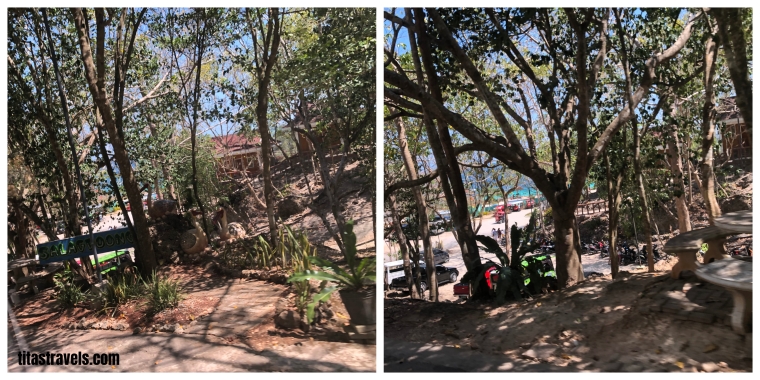 Entrance of Salagdoong Beach from access road
Entrance of Salagdoong Beach from access road
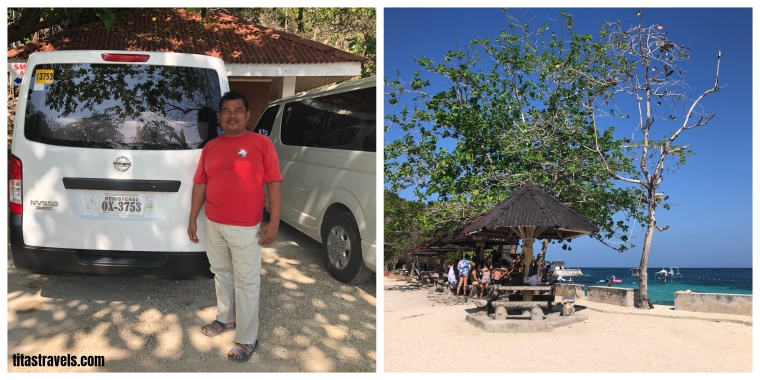

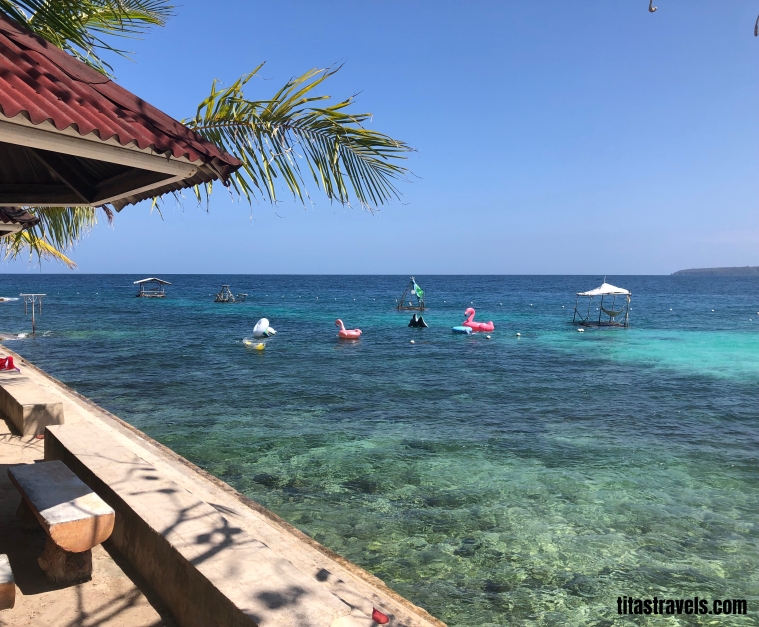
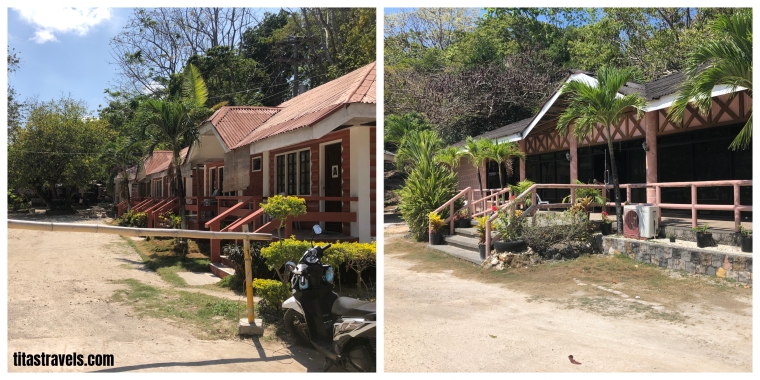


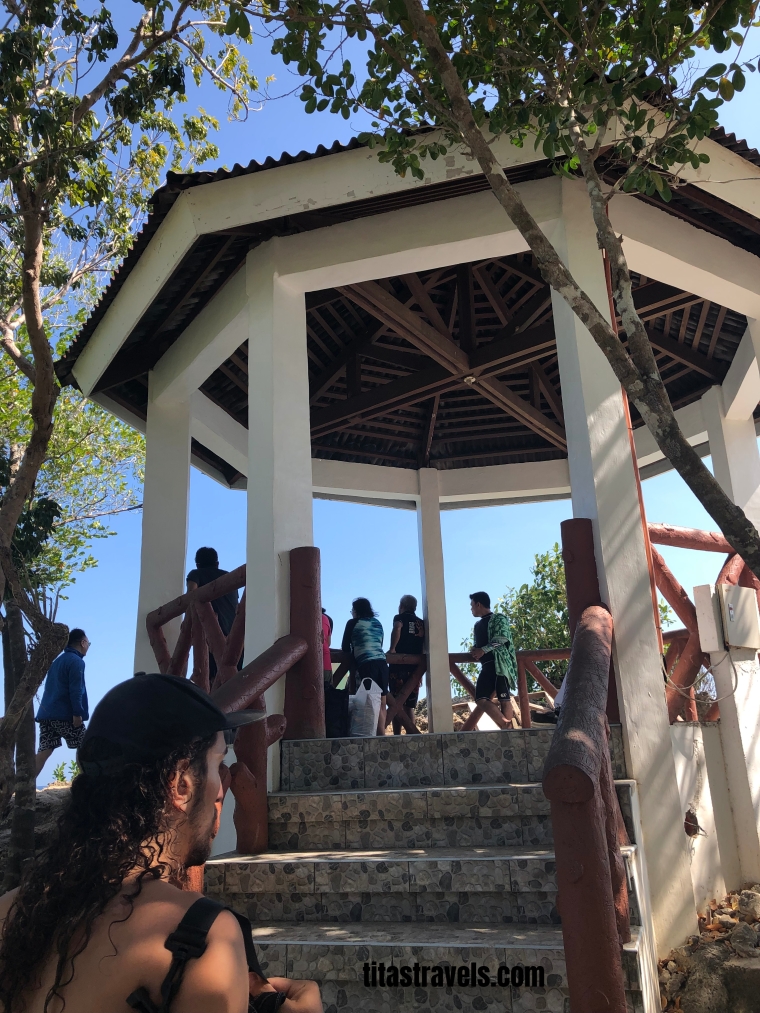
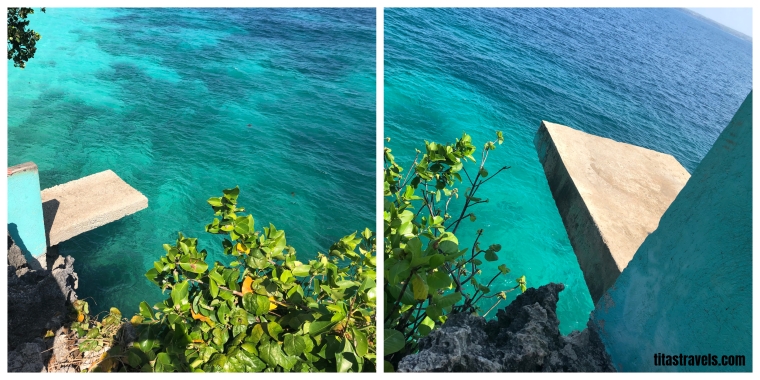
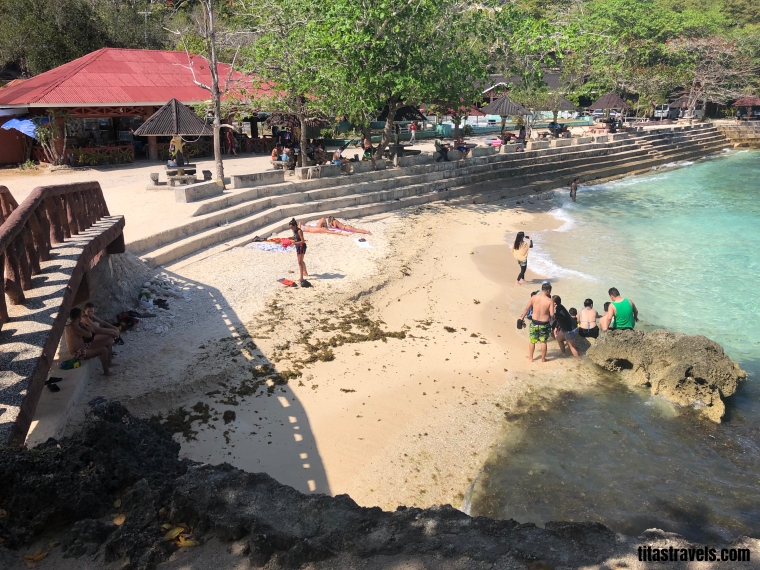

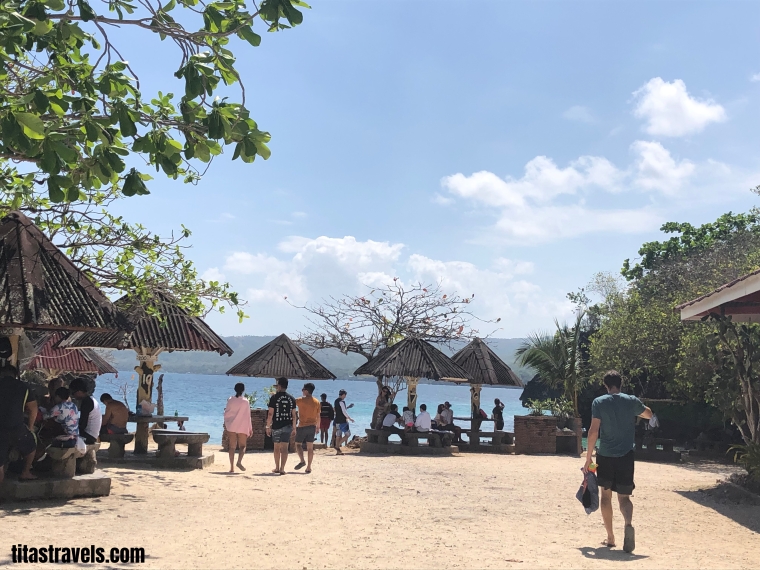
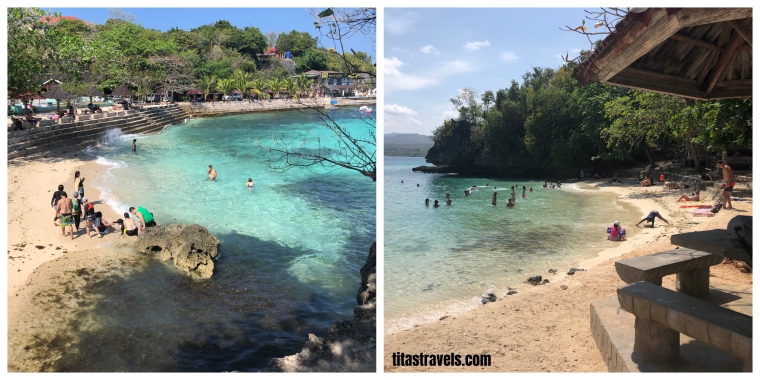



 Greg – originally posted to Flickr
Greg – originally posted to Flickr 
 Great news, target date of completion is May 21, 2019! Please give me feedback if this target was met.
Great news, target date of completion is May 21, 2019! Please give me feedback if this target was met. The Lazi Convent in 2012 (Carmelo Bayarcal, own work created June 10, 2012,
The Lazi Convent in 2012 (Carmelo Bayarcal, own work created June 10, 2012, 

 Lazi Church in 2016 (Allan Jay Quesada, own work, 20 April 2016,
Lazi Church in 2016 (Allan Jay Quesada, own work, 20 April 2016,